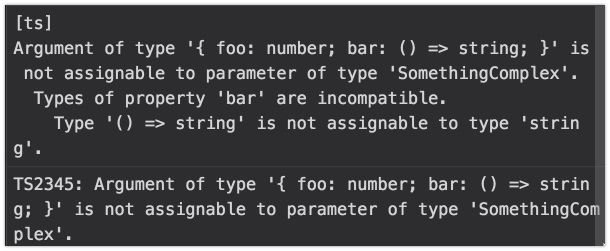에러 메세지
Since TypeScript is a heavily focused Developer Help oriented programming language, its errors messages try to be super helpful when something goes wrong. This can lead to a slight information overload for unsuspecting users of compilers that aren't so helpful.
Lets look at an example in an IDE to break apart the process of reading an error message.
type SomethingComplex = {
foo: number,
bar: string
}
function takeSomethingComplex(arg: SomethingComplex) {
}
function getBar(): string {
return 'some bar';
}
//////////////////////////////////
// Example error production
//////////////////////////////////
const fail = {
foo: 123,
bar: getBar
};
takeSomethingComplex(fail); // TS ERROR HAPPENS HEREThis example demonstrates a common programmer error where they fail to call a function (bar: getBar should be bar: getBar()). Fortunately this mistake is caught by TypeScript as soon as it doesn't meet the type requirements.
Error Categories
There are two categories of TypeScript Error messages (succinct and detailed).
Succinct
The objective of the succinct error message is to provide an example conventional compiler description of the error number and message. For this example the succinct message looks like:
It is fairly self explanatory. However, it doesn't provide a deeper breakdown of why the error is happening. That is what the detailed error message is for.
Detailed
For this example the detailed version looks like:
The objective of the detailed error message is to guide the user to the reason why some error (type incompatibility in this case) is happening. The first line is same as the succinct, followed by a chain. You should read this chain as a series of responses to the developer question WHY? between lines i.e
So the root cause is,
for property
barthere is a function
() => stringwhile it was expected as astring.
This should help the developer fix the bug for the bar property (they forgot to invoke () the function).
How it shows up in an IDE Tooltip
The IDE normally shows the detailed followed by the succinct version in a tooltip as shown below:

You normally just read the
detailedversion forming theWHY?chain in your head.You use the succinct version if you want to search for similar errors (using the
TSXXXXerror code or portions of the error message)
Last updated
Was this helpful?